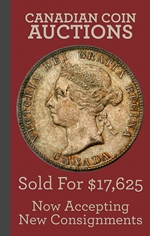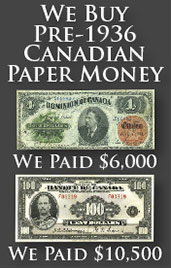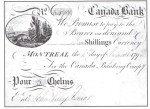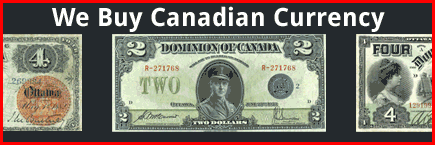We Buy All Canadian Currency
Printed Before 1936
We Also Accept Consignments for Manifest Currency Auctions
Email Us: Manning@CanadaCurrency.com or Call or Text: 864-430-4020
Thank you! -Manning Garrett
Canadian Chartered Bank Notes | Value Guide
Rare Canada Bank Notes from Chartered Banks
There is a special subset of collectors out there who focus on the now out of business chartered banks that were in Canada during the 19th and early 20th centuries. Prices for Canadian chartered bank notes can range from about $20 to thousands of dollars. There is really is no trick to knowing what something is worth. You just have to work with an expert (and we definitely consider ourselves experts). Our guide below has information about 164 different charter banks. The guide is sorted by town name and then bank name. Banks could have branches in more than just one city. So the town name on your bank note might be different than the city we have it sorted by. Keep that in mind if you have trouble finding your exact bank.
Scroll Down For The Bank And Price Guide
If you want to know how much your bank note is worth, then we strongly encourage you to contact us directly via our email address. We can tell you how much your bank note should sell for based on its condition and rarity. Manning@CanadaCurrency.com. We have a few factors that you should at least be aware of when attempting to understand the value of any bank note from a charter bank in Canada.
Location, Location, Location
This is very important to understand. Rarity and condition are the two most important things that affect the value of bank notes from Canada. Location of the issuing bank is the third most important factor. You can scroll down to see a list of the 59 different towns that had chartered banks. Many of these towns only had one bank. Some cities like Toronto and Montreal had dozens of banks. Generally speaking, a bank note from a small one bank town is going to be worth more than an equally rare bank note from a big city. It is just a supply and demand thing. For example, there might be five collectors looking to buy a note from all 59 issuing cities; but there might only be two people looking to buy a note from all 164 banks. Simply put, the piece of currency from the one bank town is going to appeal to more people, even if it isn’t rarer than the same bank note from a big city.
Older Isn’t Always Better
Don’t let the fact that something is 150 years old make you think that you are going to be able to retire after you sell it. Charter bank notes from Canada are valued based on their rarity, not their age. There are plenty of notes from the 1900s that are worth more money than some bank notes from the 1830s. Never let age affect your opinion of value. We definitely aren’t saying that newer is better and older is bad. We are just saying that age really isn’t part of the equation when you do an appraisal on an antique bank note.
Eye Appeal Matters
Don’t get too caught up on location, age, and statistics. That stuff matters, but sometimes beauty trumps everything else. The earliest bank notes from Canada are often times very rare, but they just aren’t very attractive. The paper was thin and the overprints were boring. Colorful and modern looking bank notes were first printed for Canada banks in the 1880s. Based on statistics alone, some common bank notes should be worth $50 each. However, because they are universally considered to be works of art, they might sell for as much as $500. The opposite applies to ugly bank notes. Once again, based on rarity alone, certain bank notes should probably be worth $500. However, because they are ugly, they might only sell for $50. Look at the colors and the vignettes on your bank note. Is this something you would be proud to own and display?
Look At The Serial Number
The serial number on a Canadian bank note really only adds value if it is serial number one, which could read like 00001. You probably don’t have a #1, but you can still look at the serial number and get some information from it. If the number is over one million then you almost certainly have a relatively common bank note. If the serial number is six digits then it won’t be a super rarity, but it could certainly still be valuable. A bank note from Canada with a serial number under 100,000 has a chance to be rare. If the number is under 10,000 then you could have a great find. Just remember that even notes that were printed by the millions still started at serial number one. So just because the number is low doesn’t guarantee rarity; but it is a step in the right direction. For the record, serial number premiums don’t really apply to hand numbered bank notes.
Issued vs. Specimens vs. Remainders
Most collectors of Canadian chartered bank notes are looking for currency that was actually issued and released for circulation. Issued notes have serial numbers and signatures. Specimen notes usually have no serial number or they have the number 000000. Specimens were given to banks and government institutions so they would know what authentic currency looked like. Remainders are typically only going to be found from the early days of banking in Canada. Remainders are the worthless money that was left over (unissued) by banks when they closed. They are not worthless today. Remainders usually aren’t dated, numbered, or signed. All of these bank notes could be valuable. However, issued bank notes are definitely the most popular.
Higher Denominations Are Better
Generally speaking, a $100 bill is going to be rarer than a $1 bill. It was easy to forget about or save a $1 bill in the 19th century. On the other hand, people usually went out of their way to not get stuck with a $100 bill; its purchasing power was tremendous. Lower denominations are much more plentiful today when compared to higher denominations (like $50 and $100 bills). And as we have established, rarer means more money.
Chartered Bank Note Guide
The banks below are sorted by town name and then bank name. Please contact us if you need help valuing your bank note. WE ARE ALSO INTERESTED BUYERS.
Amherst
Canadian Chartered Bank Notes from Amherst, Nova Scotia:
Bath
Canadian Chartered Bank Notes from Bath, Ontario:
Boucherville
Canadian Chartered Bank Notes from Boucherville, Quebec:
Bowmanville
Canadian Chartered Bank Notes from Bowmanville, Ontario:
Brantford
Canadian Chartered Bank Notes from Brantford, Ontario:
Brockville
Canadian Chartered Bank Notes from Brockville, Ontario:
Charlottetown
Canadian Chartered Bank Notes from Charlottetown, Prince Edward Island:
Chatham
Canadian Chartered Bank Notes from Chatham, Ontario:
Chippewa
Canadian Chartered Bank Notes from Chippewa, Ontario:
Clifton
Canadian Chartered Bank Notes from Clifton, Province of Canada:
Collingwood
Canadian Chartered Bank Notes from Collingwood, Ontario:
Elgin
Canadian Chartered Bank Notes from Elgin, Ontario:
Fort Erie
Canadian Chartered Bank Notes from Fort Erie, Ontario:
Fredericton
Canadian Chartered Bank Notes from Fredericton, New Brunswick:
Goderich
Canadian Chartered Bank Notes from Goderich, Ontario:
Halifax
Canadian Chartered Bank Notes from Halifax, Nova Scotia:
Hamilton
Canadian Chartered Bank Notes from Hamilton, Ontario:
Hatley
Canadian Chartered Bank Notes from Hatley, Quebec:
Hull
Canadian Chartered Bank Notes from Hull, Quebec:
Kingston
Canadian Chartered Bank Notes from Kingston, Ontario:
La Prairie
Canadian Chartered Bank Notes from La Prairie, Quebec:
Liverpool
Canadian Chartered Bank Notes from Liverpool, Nova Scotia:
London
Canadian Chartered Bank Notes from London, Ontario:
Malbay
Canadian Chartered Bank Notes from Malbay, Quebec:
Malden
Canadian Chartered Bank Notes from Malden, Ontario:
Montreal
Canadian Chartered Bank Notes from Montreal, Quebec:
Moosejaw
Canadian Chartered Bank Notes from Moosejaw, Saskatchewan:
Niagara Falls
Canadian Chartered Bank Notes from Niagara Falls, Ontario:
Oshawa
Canadian Chartered Bank Notes from Oshawa, Ontario:
Ottawa
Canadian Chartered Bank Notes from Ottawa, Ontario:
Peterborough
Canadian Chartered Bank Notes from Peterborough, Ontario:
Petitcodiac
Canadian Chartered Bank Notes from Petitcodiac, New Brunswick:
Phillipsburgh
Canadian Chartered Bank Notes from Phillipsburgh, Quebec:
Pictou
Canadian Chartered Bank Notes from Pictou, Nova Scotia:
Prescott
Canadian Chartered Bank Notes from Prescott, Ontario:
Quebec (non-specific)
Canadian Chartered Bank Notes from Quebec Province:
Quebec City
Canadian Chartered Bank Notes from Quebec City, Quebec:
Queenston
Canadian Chartered Bank Notes from Queenston, Ontario:
Rustico
Canadian Chartered Bank Notes from Rustico, Prince Edward Island:
Saint Andrews
Canadian Chartered Bank Notes from Saint Andrews, New Brunswick:
Saint Catherines
Canadian Chartered Bank Notes from Saint Catherines, Ontario:
Saint Jean
Canadian Chartered Bank Notes from Saint Jean, Quebec:
Saint John
Canadian Chartered Bank Notes from Saint John, New Brunswick:
Saint John's
Canadian Chartered Bank Notes from Saint John's, Newfoundland:
Saint Stephen
Canadian Chartered Bank Notes from Saint Stephen, New Brunswick:
Saint Thomas
Canadian Chartered Bank Notes from Saint Thomas, Ontario:
Saint-Hyacinthe
Canadian Chartered Bank Notes from Saint-Hyacinthe, Quebec:
Sherbrooke
Canadian Chartered Bank Notes from Sherbrooke, Quebec:
Stanstead
Canadian Chartered Bank Notes from Stanstead, Quebec:
Summerside
Canadian Chartered Bank Notes from Summerside, Prince Edward Island:
Three Rivers
Canadian Chartered Bank Notes from Three Rivers, Quebec:
Toronto
Canadian Chartered Bank Notes from Toronto, Ontario:
Vancouver
Canadian Chartered Bank Notes from Vancouver, British Columbia:
Victoria
Canadian Chartered Bank Notes from Victoria, British Columbia:
Weyburn
Canadian Chartered Bank Notes from Weyburn, Saskatchewan:
Windsor
Canadian Chartered Bank Notes from Windsor, Ontario:
Winnipeg
Canadian Chartered Bank Notes from Winnipeg, Manitoba:
Yarmouth
Canadian Chartered Bank Notes from Yarmouth, Nova Scotia:
York
Canadian Chartered Bank Notes from York, Ontario:


